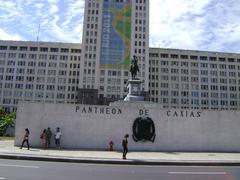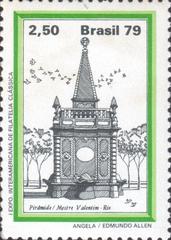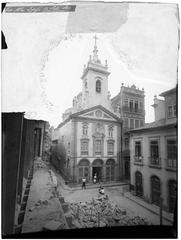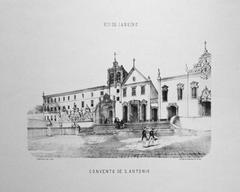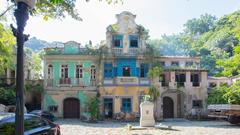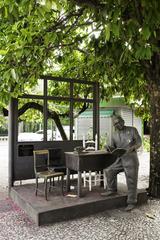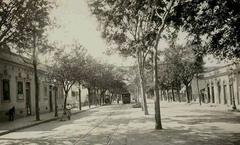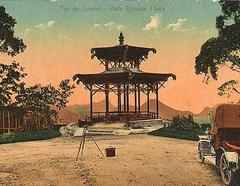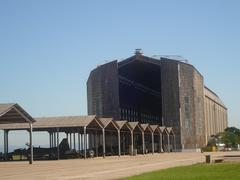Visiting Tijuca National Park: Hours, Tickets, and Tips
Date: 16/08/2024
Introduction
Nestled in the vibrant city of Rio de Janeiro, Tijuca National Park is a sprawling urban rainforest that offers visitors a unique blend of natural beauty, adventure, and cultural heritage. This comprehensive guide aims to provide everything potential visitors need to know about Tijuca National Park, from its rich history and ecological significance to practical information about hiking trails, visitor tips, and sustainable tourism practices. The park, often claimed to be the world’s largest urban forest, covers approximately 39.58 square kilometers and is a part of the Atlantic Forest Biosphere Preserve, home to an array of plant and animal species, many of which are endangered (Wikipedia). The park’s history dates back to the 1700s, when extensive deforestation for agriculture and livestock farming led to significant environmental degradation. Recognizing the critical need for conservation, Emperor Pedro II initiated reforestation efforts in the 1860s, planting over 100,000 trees and laying the foundation for the park as we know it today (Wikipedia). Today, Tijuca National Park stands as a testament to the resilience of nature and the importance of conservation, offering visitors an unforgettable experience amidst its stunning natural wonders.
Table of Contents
- [History and Significance of Tijuca National Park](#history-and-significance-of-tijuca-national-parkhistory-and-significance-of-tijuca-national-park)
- [Early History and Deforestation](#early-history-and-deforestationearly-history-and-deforestation)
- [Reforestation Efforts](#reforestation-effortsreforestation-efforts)
- [Development and Infrastructure](#development-and-infrastructuredevelopment-and-infrastructure)
- [National Park Designation](#national-park-designationnational-park-designation)
- [Ecological Significance](#ecological-significanceecological-significance)
- [Cultural and Historical Landmarks](#cultural-and-historical-landmarkscultural-and-historical-landmarks)
- [Modern-Day Challenges and Conservation](#modern-day-challenges-and-conservationmodern-day-challenges-and-conservation)
- [Sustainable Tourism and Community Engagement](#sustainable-tourism-and-community-engagementsustainable-tourism-and-community-engagement)
- [Visitor Experience and Attractions](#visitor-experience-and-attractionsvisitor-experience-and-attractions)
- [Hiking Trails](#hiking-trailshiking-trails)
- [Pedra da Gávea](#pedra-da-gáveapedra-da-gávea)
- [Pico da Tijuca](#pico-da-tijucapico-da-tijuca)
- [Pedra Bonita](#pedra-bonitapedra-bonita)
- [Waterfalls and Caves](#waterfalls-and-caveswaterfalls-and-caves)
- [Cascatinha Taunay](#cascatinha-taunaycascatinha-taunay)
- [Gruta Paulo e Virgínia](#gruta-paulo-e-virgíniagruta-paulo-e-virgínia)
- [Adventure Activities](#adventure-activitiesadventure-activities)
- [Hang Gliding](#hang-glidinghang-gliding)
- [Rock Climbing](#rock-climbingrock-climbing)
- [Wildlife and Nature](#wildlife-and-naturewildlife-and-nature)
- [Bird Watching](#bird-watchingbird-watching)
- [Monkeys and Other Wildlife](#monkeys-and-other-wildlifemonkeys-and-other-wildlife)
- [Cultural and Historical Sites](#cultural-and-historical-sitescultural-and-historical-sites)
- [Vista Chinesa](#vista-chinesavista-chinesa)
- [Mayrink Chapel](#mayrink-chapelmayrink-chapel)
- [Visitor Tips](#visitor-tipsvisitor-tips)
- [Best Time to Visit](#best-time-to-visitbest-time-to-visit)
- [Guided Tours](#guided-toursguided-tours)
- [Safety Precautions](#safety-precautionssafety-precautions)
- [Visiting Hours and Tickets](#visiting-hours-and-ticketsvisiting-hours-and-tickets)
- [Nearby Attractions](#nearby-attractionsnearby-attractions)
- [FAQ](#faqfaq)
History and Significance of Tijuca National Park
Early History and Deforestation
The area now known as Tijuca National Park has a rich history that dates back to the 1700s. During this period, the forests surrounding Rio de Janeiro were extensively cleared to provide fuel, cultivate coffee, and support livestock farming. This deforestation had significant ecological impacts, including the disruption of small streams that were crucial for the city’s water supply. The resulting environmental degradation led to water shortages and flash floods, highlighting the need for reforestation and conservation efforts.
Reforestation Efforts
In 1861, Emperor Pedro II of Brazil recognized the critical need to restore the forest and placed the area under federal control. This marked the beginning of a significant reforestation project, which was overseen by Major Manuel Gomes Archer. The reforestation efforts were carried out by six enslaved individuals—Eleutério, Constantino, Manuel, Mateus, Leopoldo, and Maria—who planted over 100,000 trees between 1861 and 1887. This monumental task laid the foundation for the contemporary Tijuca National Park and its surrounding forests.
Development and Infrastructure
The late 19th and early 20th centuries saw further developments in the park. A cog railway was constructed to transport passengers to the top of Corcovado Mountain, where the iconic Christ the Redeemer statue was erected between 1922 and 1931. This period also saw the establishment of various trails and infrastructure that would later become popular tourist attractions.
National Park Designation
In 1961, the Tijuca Forest was officially declared a national park, solidifying its status as a protected area. This designation was a significant milestone in the park’s history, ensuring the preservation of its unique ecosystems and biodiversity. The park’s importance was further recognized in 2011 with the establishment of the Carioca Mosaic, a conservation initiative that includes Tijuca National Park. In 2012, UNESCO designated the landscapes around Rio de Janeiro, including the park, as a World Heritage Site.
Ecological Significance
Tijuca National Park is often claimed to be the world’s largest urban forest, covering approximately 39.58 square kilometers (15.28 square miles). This title, however, is disputed with Johannesburg, South Africa. The park is part of the Atlantic Forest Biosphere Preserve and is home to hundreds of plant and wildlife species, many of which are threatened by extinction. The dense vegetation has a cooling effect on the surrounding areas, with scientists estimating that ambient temperatures have been lowered by up to 9°C.
Cultural and Historical Landmarks
The park is not only a natural sanctuary but also a repository of cultural and historical landmarks. The Mayrink Chapel, adorned with murals painted by the renowned Brazilian artist Cândido Portinari, is one such landmark. Another notable site is the Vista Chinesa, a pagoda-style gazebo that offers panoramic views of Rio de Janeiro. The park also features the Mesa do Imperador (“Emperor’s Table”), a giant granite table that adds to its historical allure.
Modern-Day Challenges and Conservation
Despite its protected status, Tijuca National Park faces several modern-day challenges. Frequent, accidental fires set by humans pose a significant threat to the park’s ecosystems. These fires are often exacerbated by the colonization of more flammable grasses that displace native vegetation. Additionally, the park is heavily used by visitors, with over 3.3 million people visiting in 2016 alone. This high footfall necessitates ongoing conservation efforts to mitigate environmental degradation.
Sustainable Tourism and Community Engagement
Tijuca National Park has implemented various sustainable tourism practices to preserve its natural resources and support local communities. These initiatives include waste management programs, reforestation projects, and conservation efforts focused on preserving the park’s rich flora and fauna. By engaging in these efforts, the park aims to maintain its natural beauty and safeguard its diverse ecosystems for future generations.
Visitor Experience and Attractions
The park offers a plethora of attractions that cater to a wide range of interests. Hiking enthusiasts can explore numerous trails leading to destinations such as Diamantina’s Waterfall, Parrot’s Beak (Bico do Papagaio), and Tijuca’s Peak (Pico da Tijuca). For those interested in cultural and historical insights, the park provides a glimpse into Brazil’s colonial past and the traditional practices of communities living in and around the park.
Hiking Trails
Pedra da Gávea
Pedra da Gávea is one of the most iconic hikes in Tijuca National Park. This 842-meter-high granite monolith offers a challenging 6-hour hike that rewards climbers with some of the best views in Rio de Janeiro. The trail cuts through wildlife-filled rainforests and involves a rope-assisted scramble over a sheer precipice, making it suitable only for the fit and vertigo-tolerant. The views from the summit are breathtaking, encompassing the Christ the Redeemer statue and Rio’s beaches (Bucket List Travels).
Pico da Tijuca
Pico da Tijuca, the highest peak in Rio at just over 1,000 meters, offers an exceptional 3-hour hike. The trail is one of the best walks in the park, cutting through wildlife-filled forest and climbing steeply through a long staircase of steps cut into the rock face. The summit provides spectacular views of Rio’s landscape of bays and forest-covered mountains (Bucket List Travels).
Pedra Bonita
Pedra Bonita is another popular hiking destination, known for its relatively short and easier trail. The hike takes around 40 minutes and offers stunning views over southern Rio. This peak is also famous for hang gliding, making it a must-visit for adventure enthusiasts (Bucket List Travels).
Waterfalls and Caves
Cascatinha Taunay
Cascatinha Taunay is the tallest waterfall in Tijuca National Park, standing at 30 meters. It is easily accessible and a popular spot for visitors looking to enjoy the natural beauty of the park. The waterfall is surrounded by lush vegetation and offers a serene environment for relaxation and photography (Bucket List Travels).
Gruta Paulo e Virgínia
Gruta Paulo e Virgínia is one of the many caves in the park, offering a unique experience for visitors. The cave is named after a famous Brazilian novel and provides an interesting exploration opportunity for those interested in geology and history (Bucket List Travels).
Adventure Activities
Hang Gliding
Hang gliding off Bonita Rock (Pedra Bonita) is a bucket-list experience for many visitors. The 520-meter-high monolith provides an excellent launch point, with warm weather and coastal mountains creating almost constant thermals. Numerous operators offer tandem or solo flights, making it accessible for both beginners and experienced gliders. The views during the flight are spectacular, with boulder-mountain studded bays and broad sandy beaches serving as landing strips (Bucket List Travels).
Rock Climbing
For serious mountain climbers, Tijuca National Park offers a range of guided climbs up Pedra da Gávea. The climbs are challenging and require a good level of fitness and agility. The experience is rewarding, with incredible views and a sense of accomplishment upon reaching the summit (Bucket List Travels).
Wildlife and Nature
Bird Watching
Tijuca National Park is a haven for bird watchers, with a diverse range of bird species inhabiting the park. Toucans, parrots, and various other tropical birds can be spotted along the trails. The best time for bird watching is early morning during the dry season (April-November) when the wildlife is most active (Bucket List Travels).
Monkeys and Other Wildlife
The park is home to a variety of wildlife, including monkeys as small as kittens. Visitors can often spot these playful creatures along the trails. The park’s diverse ecosystem also includes other mammals, reptiles, and a rich variety of plant species, making it a fascinating destination for nature lovers (Bucket List Travels).
Cultural and Historical Sites
Vista Chinesa
Vista Chinesa is a Chinese-style pavilion offering panoramic views of Rio de Janeiro. Built in the early 20th century, it is a popular spot for tourists and locals alike. The pavilion provides a unique cultural experience and a great vantage point for photography (Bucket List Travels).
Mayrink Chapel
Mayrink Chapel is a small, picturesque chapel located within the park. Built in the 19th century, it features beautiful frescoes painted by the famous Brazilian artist Cândido Portinari. The chapel is a peaceful spot for reflection and offers insight into the historical and cultural heritage of the area (Bucket List Travels).
Visitor Tips
Best Time to Visit
The best time to visit Tijuca National Park is during the dry season, from April to November. Early mornings are ideal for wildlife sightings and avoiding the heat. The park can be miserable when it’s raining and unsafe after dark (Bucket List Travels).
Guided Tours
Organized tours are highly recommended for exploring the park. Various tours are available, including half-day hikes, full-day hikes, and specialized tours focusing on specific attractions like waterfalls and caves. These tours often include pick-up and drop-off services, making logistics easier for visitors (Bucket List Travels).
Safety Precautions
Visitors should take safety precautions while exploring the park. It is essential to stay on marked trails, carry sufficient water, and wear appropriate footwear. The park is generally safe, but it is advisable to avoid visiting alone or after dark (Bucket List Travels).
Visiting Hours and Tickets
Tijuca National Park is open daily from 8:00 AM to 5:00 PM. There is no entrance fee, but some attractions within the park may have separate charges. It’s recommended to check the official park website for the latest information on visiting hours and ticket prices.
Nearby Attractions
In addition to the wonders of Tijuca National Park, visitors can explore nearby attractions such as the Christ the Redeemer statue, Sugarloaf Mountain, and the vibrant neighborhoods of Rio de Janeiro. These sites offer additional cultural and natural experiences to complement your visit.
FAQ
Q: What are the best times to visit Tijuca National Park?
A: The best time to visit is during the dry season, from April to November. Early mornings are ideal for wildlife sightings and avoiding the heat.
Q: Are there guided tours available in Tijuca National Park?
A: Yes, organized tours are highly recommended and available. Options include half-day hikes, full-day hikes, and specialized tours focusing on specific attractions.
Q: What are the visiting hours and ticket prices for Tijuca National Park?
A: The park is open daily from 8:00 AM to 5:00 PM. There is no entrance fee, though some attractions may have separate charges. Check the official website for the latest information.
Conclusion
Tijuca National Park stands as a testament to the resilience of nature and the importance of conservation. Its rich history, ecological significance, and cultural landmarks make it a must-visit destination for anyone traveling to Rio de Janeiro. Through sustainable practices and community engagement, the park continues to thrive, offering visitors an unforgettable experience amidst its stunning natural wonders.
For more detailed information, you can visit the Wikipedia page on Tijuca National Park and Veronika’s Adventure.
References
- Wikipedia contributors. (2023). Tijuca National Park. Wikipedia, The Free Encyclopedia. https://en.wikipedia.org/wiki/Tijuca_National_Park
- Bucket List Travels. (2023). Exploring Tijuca National Park. https://www.bucketlisttravels.com/experience/tijuca-national-park
- Travellers Worldwide. (2023). Best Time to Visit Rio de Janeiro. https://travellersworldwide.com/best-time-to-visit-rio-de-janeiro/






